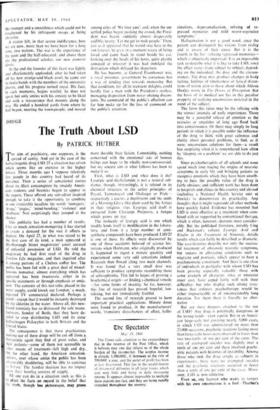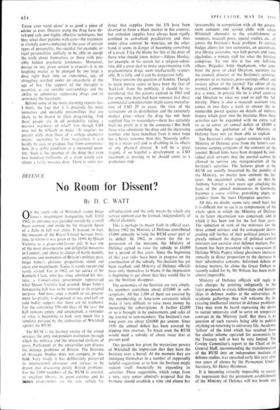DRUGS
The Truth About LSD
By PATRICK HUTBER
THe aim of psychiatry, one supposes, is the spread of sanity. And yet in the case of the hallucinogenic drug LSD 25 a situation has arisen which seems like an exercise in the higher lunacy. Three months ago I suppose relatively few people in this country had heard of its existence. Then a series of sensational stories- about its illicit consumption by (mainly Ameri- can) students and beatniks began to appear in the papers. These offered any sub-editor inspired enough to take it the opportunity to combine in one irresistible headline the words 'teenagers,'
'drugs; 'orgies,' and `madness.' Not surprisingly they jumped at the chance.
This publicity has had a number of results. like so much sensation-mongering it has started to create a demand for the vice it affects to deplore. On April 27, in what was stated to be the first case of its kind, a man appeared at Marlborough Street magistrates' court accused of unlawful possession of LSD. He told the magistrate he had first read of the drug in London Life magazine, and then inquired after it among patrons of a Chelsea coffee bar. The public has been fed with a great deal of miscel- laneous nonsense; almost everything which has appeared has been inaccurate, either in its specific statements or through emphasis or omis- sion. 'The contents of this test-tube, placed in the water supply, could knock out London,' a much- repeated TV commercial declared. Perhaps it could —except that it would be instantly destroyed by the chlorine in the water. Above all, this new- found notoriety has so distressed the sole manu- facturers, Sandoz of Basle, that they have de- cided to stop distributing LSD and its sister hallucinogen Psilocybin in both Britain and the United States.
The consequence is that those psychiatrists making use of these drugs will be cut off from a . therapeutic agent they find of great value, and their patients—some of them not accessible to other means of treatment—left high and dry... On the other hand, the American sensation: seekers, over whose antics the public has been Pleasurably shuddering, will be able to continue. is before. The Sandoz decision has no impact upon their bootleg sources of supply.
All one can do in a situation such as this is to place the facts on record in the belief that the truth, though less picturesque, may ProYe more durable than fiction. Lamentably, nothing concerned with the emotional side of human beings can hope to be wholly non-controversial, but my sincere aim in what follows has been to make it so.
First, what is LSD and what does it do? Lysergic acid diethylamide is not a natural sub- stance. though, interestingly, it is related in its chemical structure to the active principles of Peyotl. Teonanacatl and Ololiuqui or Piule- respectively a cactus, a mushroom and the seeds of a Morning Glory-like plant used by the Aztecs in their religious rites. Lysergic acid itself is extracted from Claviceps Purpurea, a fungus which grows on rye.
The molecule of lysergic acid is one which readily lends itself to modification in the labora- tory, and from it a large number of semi- synthetic compounds have been produced. LSD 25 is one of these. Its effects were discovered by one of those accidents beloved of science his- torians when Hofmann, who originally produced it, happened to ingest a minute quantity and experienced some very odd sensations indeed. Research then flowed along two main channels. It was found that a very small dose was sufficient to produce symptoms resembling those of schizophrenia. This led to hopes of proving a biochemical origin—or finding a chemical remedy —for some forms of insanity. So far, however, this line of research has proved hopeful, tan- talising, but not immediately fruitful.
The second line of research proved to have important practical applications. Minute doses were found to produce, in the manufacturers' words, 'transitory disturbances of affect, hallu- cinations, depersonalisation, reliving of re- pressed memories and mild neuro-vegetative symptoms.'
Hallucination is not a good word, since the patient can distinguish his visions from reality and is aware of their cause. But it is the fourth in the list—reliving repressed memories— which is objectively important. It is an impossible task to describe what it is like to take ISD, since the effect varies from subject to subject, depend- ing on the individual, the dose and the circum- stances. The drug may produce changes in body feeling, feelings of timelessness or lyrical distor- tions of vision akin to those about which Aldous Huxley wrote in The Doors of Perception. But the basis of its medical use lies in this peculiar property of realising unconscious material in the mind of the subject.
The form this takes may be the reliving with the utmost intensity of early experiences. There may be a powerful release of emotion as the ecstasies or anguishes of long ago flood back into consciousness. Or there may simply be long periods in which it is possible under the influence of the drug to think with great calmness and clarity about personal problems, to find, as it were, unconscious solutions for them—a result less surprising when it is remembered how often by 'sleeping on a problem' we are able to do just this.
Since psychotherapists of all schools and none spend much time tracing the origins of neurotic symptcnns in early life and bringing patients to recognise emotions which they have been unwill- ing to face, the possible value of the drug is fairly obvious; and sufficient work has been done in hospitals and clinics in this country and abroad (including a National Health Service unit at Powick) to demonstrate its practicality. Any thoughts that it might supersede all other methods have quickly faded. Evidence has mounted that LSD is most effective as a treatment when com- bined with or supported by conventional therapy, which it often, however, shortens most consider- ably. But the published literature, notably Ling and Buckman's volume Lysergic Acid and Ritalin in the Treatment of Neurosis, details results which can fairly be described as dramatic. The case-histories describe not only the success- ful treatment of obviously neurotic symptoms, but success in alleviating conditions such as migraine and psoriasis. which appear to have a psychosomatic constituent. And there is one class of individuals in particular with whom LSD has been proving especially valuable—those with some strength of character, who, at whatever inner cost, have coped fairly well with their difficulties but who display such strong resis- tances that ordinary psychotherapy would be either impracticable or of unconscionably long duration. For them there is literally no alter- native.
But are there dangers attached to the use of LSD? Any drug is potentially dangerous in the wrong hands--even aspirin. But in an Ameri can large-scale test covering nearly 5,000 cases, in which I.SD was administered on more than 25,000 occasions, psychotic reactions lasting more than forty-eight hours were observed in fewer than two two-tenths of one per cent of the cases. The rate of attempted suicides was slightly over a tenth of one per cent and these involved psychi-. atric patients with histories of instability. Among those who took the drug simply as subjects in experiments, there were no attempted suicides and the psychotic reactions occurred in fewer than a tenth of one per cent of the cases. More- over, LSD is non-addictive.
Even so,,any layman who wants to tamper with his own unconscious is a fool —Thurber's.
'Leave your mind alone' is as good a piece of advice as ever. Doctors using the drug have de- veloped safe and highly effective techniques, but they select their patients with care—the treatment is strongly contra-indicated in the case of certain types of personality, the suicidal, for example, or rigid personalities unlikely to be able to accept the truth about themselves, or those with pos- sibly hidden psychotic tendencies. Moreover, dosage in any given session is crucial—it is no laughing matter to be plunged by too large a dose right back into an experience„ say, of struggling terrified under an anaesthetic at the age of five. The support of the therapist is essential, as are suitable surroundings and the ability to administer supporting drugs and to terminate the treatment.
Behind some of the more alarming reports lies. I think, the fact that it is precisely the most immature and unstable personalities that are likely to be drawn to illicit drug-taking. And these people are in all probability taking a massive overdose—of what? For though LSD may not be difficult to make Olt requires no greater skills than those of a college chemistry major,' according to Time magazine), it can hardly be easy to produce free from contamina- tion, in a stable condition or a measured quan- tity. Such is the potency of the drug that even two hundred millionths of a scram would con- stitute a fairly massive dose. There is some evi-
dente that supplies from the US have been diverted to form a black market in this country, but orthodox supplies have always been rigidly confined to consultant psychiatrists and thus under close control. In America, on the other hand, it seems in danger of becoming something of a craze. I lay the blame for this at the door of those who should know better—Aldous Huxley, for example, in his search for a religion-substi- tute, did a great deal to make experimenting with psychomimetic drugs seem intellectually respect- able. It is folly and it can be dangerous folly.
There remains the question of Sandoz. Though its main motive seems to have been the fear of 'backlash' from the publicity, it should be re- membered that the patents expired in 1963 and for some time there had been rumours that sheer commercial considerations might cause manufac- ture of LSD 25 to cease. (In view of the restrictions on its distribution and the extremely modest price—where the drug has not been supplied free to researchers—there has certainly been no profit in it to the company.) But both those who administer the drug and the increasing number who have benefited from it must hope for a better outcome than this. Neurotic suffer- ing is a major evil and as disabling in its effects as any physical disease. It will be a great tragedy if so hopeful a development as LSD treatment is proving to be should come to a premature stop.



































 Previous page
Previous page